This summer’s weather, with hot humidity and sudden downfalls of rain has been ideally suited for the Sanctuary Lakes weeds. Presently they can be seen in riotous growth all over the resort, on the course, nature strips and gardens. Whether they’re strangling your favourite flowering plant, prickling your feet, or just plain looking ugly, weeds can be the bane of every Sanctuary Lakes gardener.
But what is the definition of a weed. Well generally they are plants that aren’t wanted, but turn up anyway. The Government Botanists define weeds as species which, when introduced into the natural environment, are detrimental to our native plants, animals and ecosystems. Many of these plant/weeds were first brought to Australia deliberately and some are even still grown in gardens deliberately. It’s when they spread beyond where they’re purposefully sown that they become weeds.
There are literally hundreds of weed species growing in Sanctuary Lakes, but I thought we could look at five of the most obvious and notable species seen in almost all of our gardens, on the fringes of the golf course and our nature strips. Starting with probably the most familiar weed of all, the Dandelion.
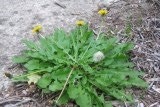
Common Dandelion Taraxacum officinale
Common Dandelion is well known for its pretty yellow flower heads which turn into round balls of silver tufted seeds, that disperse in the wind. Their jagged leaves are 5–45 cm long and 1–10 cm wide, they are sharply tipped, with sparsely backwardpointing lobes. The name is derived via the French from the shape of their leaves, dent de lion or lion’s teeth. The bright cheery flowers are on a single, smooth stem, the flower heads lack receptacle bracts and are called florets.
What is probably not common knowledge is that Dandelion has a multitude of culinary uses. The flowers are used to make dandelion wine, the leaves can be eaten, cooked or raw in various forms, such as in soup or salad. They are probably closest in character to mustard greens. Usually the young leaves and unopened buds are eaten raw in salads, while older leaves are cooked. The roots when baked and ground into powder are used to make a coffee substitute.
Thanks to their deep stubborn roots and the fun blowing round balls containing hundreds of seeds, the Dandelion has all but infested the fringe areas of our Resort. Perhaps we should try making them useful and harvesting them.
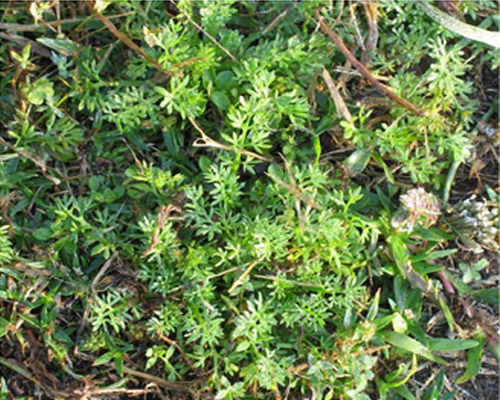
Bindii Soliva sessilis
When working or touching weeds it is advisable to always wear gloves, no more so than when you are weeding Bindii. From personal experience, without gloves I weeded a small Bindii, within minutes an unpleasant rash started on my hands and face. Bindii is also dangerous to animals. Digesting the plant can make them quite ill.
Bindii is well known for its prickly burrs which come off and stick to clothes, pets or the bottom of your shoes and feet. It also grows tiny bright yellow flowers (each with five petals) amongst its small, 1-2 cm fern-like leaves. It can spurt up during summer across our gardens and lawns as wide flat mats made of branching stems. While above ground it tends to grow horizontally rather than vertically, but underground its roots grow deep and secure. There is very little to recommend Bindii.
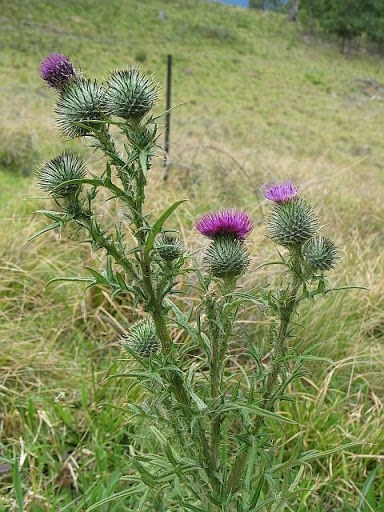
Scotch Thistle Onopordum acanthium
The Scottish Thistle or Herald Thistle takes its name from the folkloric value bestowed on the plants in Scotland, where the bright purple flower is the national floral emblem, one of pride and strength. Over here the thistles tell a totally different story. This is due to its prolific growth that quickly made it the most hated plant in Colonial Australia. In 1852 it was the first legally declared weed in the history of this country.
Scotch Thistle generally has one main stem commonly 1-1.2 m with numerous branches and broad spiny wings covered with dense woolly hairs, giving a whitish appearance. Leaf margins of Scotch thistle are cut or toothed, spiny and undulating. Dense, white woolly hairs grow on the undersides of leaves. Rosette leaves are stalked and grow up to 40 cm long. Stem leaves are smaller and without stalks, extending into wings along the stems.
Scotch thistle florets are purple or mauve in heads surrounded by numerous spiny bracts (modified leaves at the base of flower). Heads are 2-6 cm in diameter, solitary or in groups towards the ends of the branches. Seeds of Scotch thistle are 4-5 mm long, grey with dark mottling and are attached to a pappus (parachute) of toothed hairs or bristles up to twice as long as the seed. One plant is capable of dispersing over a thousand seeds a season.
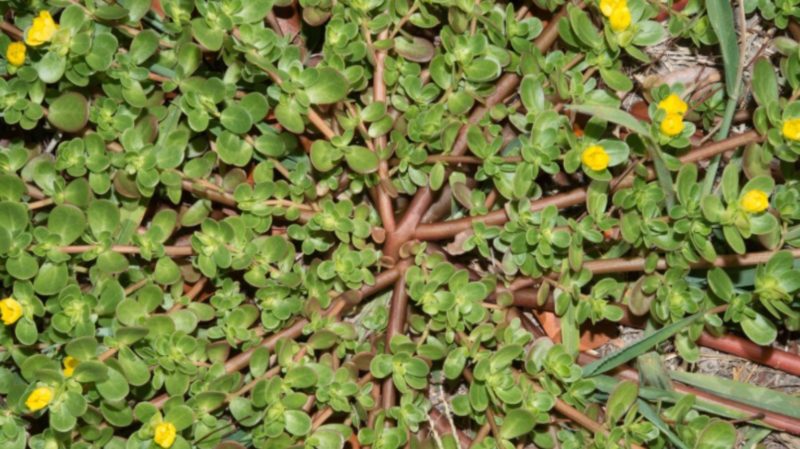
Purslane Portulaca oleracea
The last few summers has seen Purslane or Pigweed or Hogweed or Penier de Plenty, further establishing itself into Sanctuary Lakes gardens and fringes of the course.
While an Australian native and a popular food for Indigenous Australians who enjoy the fleshy leaves salty tang, Purslane family is widespread globally. Its use is documented from the Middle East by the ancient Persians, and it is still widely eaten as a cooked or salad vegetable in the Mediterranean.
The taproot is deep and helps loosen compact soils. The stem is succulent and grows flat to the ground. The small paddle shaped 1cm leaves grow subopposite or alternate to the stems. The tiny flowers are complete, bisexual and yellow.
The Purslane plant can be a difficult weed to control. Much like a zombie, even after you think you have killed it, it can come back to life again and again. The best method for eliminating Purslane is by hand pulling and make sure you glean that deeply embedded tap root.
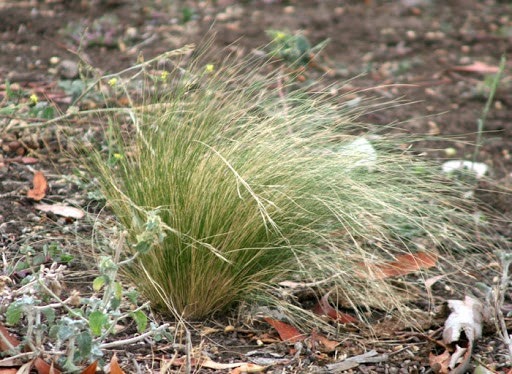
Serrated Tussock Nassella trichotoma
Finally, the Serrated Tussock which is a Weed of National Significance. Thanks to its tough perennial tussock-forming grass that can live for more than 20 years. It is regarded as one of the worst weeds in Australia due to its invasiveness, potential for spread, and economic and environmental impacts.
Serrated Tussock has a deep fibrous root system. It grows to a height of 600 mm with a maximum diameter at its base of 150 mm. The leaves are very thin (0.5 mm diameter) and tightly rolled, with small easily felt serrations along their length. The leaves are green in summer and turn yellow-green in winter with a white base. Tips of old leaves are bleached and fawn in colour.
Seeds are mainly spread by wind. Mature plants can produce more than 140,000 seeds per plant per year, and the very light seed head can be blown by wind over long distances (up to 20 km)
Serrated Tussock can be seen in the rough of the Golf course. What is not generally known or indeed spoken, is that Serrated Tussock enjoys digesting golf balls, particularly mine.